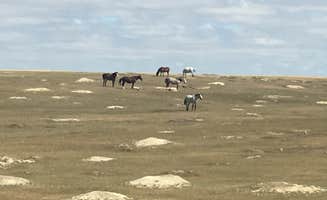Equestrian camping near Watford City, North Dakota offers riders access to extensive badlands terrain. The Little Missouri River forms the primary drainage system for this area, which sits at approximately 1,900 feet elevation with rolling hills and steep buttes. Summer temperatures regularly exceed 90°F, while winter conditions often drop below freezing with significant snowfall possible from November through March.
What to do
Trail riding accessibility: Little Missouri State Park Campground offers direct access to over 45 miles of marked horse trails. "This park is outstanding. There are many amenities including electrical hookups, water, horse corrals vault toilets and pay showers. But the amenities aren't why you stay at this park. You stay for the views. The horse and hiking trails are unbelievable," notes Jessica S.
Badlands exploration: Riders can access the Maah Daah Hey Trail from multiple points near Watford City. "A little difficult to access if you've never been but worth it. Direct access to 100+ miles of the Maah Daah Hey trail!" reports Jared F. This trail system connects through several campgrounds in the region.
Wildlife viewing: Horse riders frequently encounter wildlife on trails. "During the drive you can see buffalo on the side eating," mentions Jasmine L. about approaching the area. Sites near prairie dog towns provide additional wildlife viewing opportunities from horseback.
What campers like
Natural solitude: Elkhorn Campground provides a quiet base for horse camping. "Not a busy spot, there was only one other person camping when we were there mid first week of August. Toilet available and drinking water (you have to manually pump)," shares Brittany.
Evening atmosphere: Many equestrian campers appreciate the night skies. "At night the sky was lit from ND oil drilling gas release," notes Olson H. about the unique evening atmosphere. Others report excellent stargazing opportunities away from city lights.
Ranger programs: Educational opportunities enhance the equestrian camping experience. "Park Rangers provide educational classes from Thursday-Sunday evenings," explains Cable A., describing the evening programs available to campers, including those focusing on local wildlife and history.
What you should know
Water limitations: Many equestrian sites have limited water access. "The only drinking water is at the bathroom and not meant to fill your rv with so dont come here expecting to be able to fill your rv with safe water," warns Jennifer K. about Juniper Campground.
Road conditions: Access to some horse-friendly sites requires driving on unpaved roads. "Traveled about 35 miles on unpaved road in RAV4 AWD," reports Jim M., noting the significant driving required to reach some sites. Roads can become impassable during wet conditions.
Site spacing: Horse camping requires adequate space between campsites. "The sites are spaced apart and surrounded by trees," Jenny K. explains about one campground. This spacing helps prevent horse-related conflicts between camping parties.
Tips for camping with families
Wildlife safety: Families with horses need to be aware of bison encounters. "Bison will definitely stroll through your sites if you're over by the field like we were," warns Jillian C. about campground wildlife interactions. Keep children and horses at safe distances from wildlife.
Educational opportunities: CCC Campground offers family-friendly experiences near horse trails. "Our kids especially enjoyed the ranger presentation on prairie dogs," shares Lee L., highlighting educational programs suitable for children.
Weather preparation: Temperature fluctuations affect family camping comfort. "October can be cold! It got down below freezing in the first week of October," warns Nicole C. Families should pack warm clothing even during warmer months, as temperatures can drop significantly at night.
Tips from RVers
Site selection: Horse trailers with living quarters need appropriate sites. "When this place was built, they never envisioned large rigs. So if you have one over 30 feet, just be aware you might have to wiggle your way into a site," advises Bob M. about navigating larger rigs at Magpie Campground.
Utility considerations: RVers with horse trailers should know about hookup limitations. "There's no hook-ups, and no dump station. Drinking water is available at the wash house. The drinking of the water at the fill station is discouraged due to high levels of fluoride," explains Chris A. about water quality issues.
Distance planning: RVers should calculate driving times between attractions. "We stayed at this park because the Theodore Roosevelt Nat'l Park North Unit campgrounds were closed for renovations. I mistakenly thought this park was close to the park, but it is actually a 90 minute drive," cautions Holly E., emphasizing the need to check actual driving times rather than straight-line distances.


